Origin Of Life Introduction
Earth is the only planet we know that can support life. It is a planet with vitality and is home to billions of plants and animals that share a common evolutionary track.
- The planet Earth came into existence about five billion years ago. At that time, the atmosphere of the planet Earth was extremely hot and the existence of life in any form at that high temperature was not possible.
- But then the question arises, How and when did life originate on Earth?
- Secondly, how did primitive organisms evolve into new forms resulting in the evolution of a variety of organisms on Earth?
- Actually, the fact is, no one has been able to come close to knowing exactly what led to the origin of life, and we may never know.
- However, scientists have made significant progress in understanding the chemical processes that may have led to the origin of life.
Origin of life means the appearance of simplest life form from non-living forms and Evolution of life means the gradual formation of complex organisms from simpler ones.
Read And Learn More: NEET Class 9 Biology Notes
The evolution of life on Earth has involved the following sequence of events:
- First living things, the simplest creatures, i.e. one-celled organisms came into existence. From these came more complex, multi-cellular organisms.
- Complexity meant more than just an increase in cell number.
- As cell number increased, cellular specialization came into existence, where certain cells within the Multi-cellular organism carried out specific tasks.
- These changes, for about millions, even billions of years evolved living things that we now call plants and animals.
There are many theories, but most have the same general perspective of how things came to be the way they are. Following is an account of life’s beginnings based on some of the leading research and theories related to the subject, and of course, fossil records, dating back as far as 3.5 billion years ago.
Spontaneous Generation
Spontaneous generation was the idea that living things could be produced by non-living things. One of the firm believers in spontaneous generation was Aristotle, the Greek philosopher (384-322 BC).

NEET Biology Class 9 Origin of Life Notes
- Aristotle believed that dead leaves falling from a tree into a pond would transform into fishes and those falling on soil would transform into worms and insects. He also held that some insects develop from morning dew and rotting manure.
- Egyptians believed that the mud of the Nile River could spontaneously give rise to many forms of life. The idea of spontaneous generation was popular almost till the seventeenth century.
- The theory of Spontaneous Generation was disproved in the course of time due to the experiment conducted by Francesco Redi, (1665), Spallanzani (1765), and later by Louis Pasteur (1864) in his famous Swan neck experiment.
- This theory was disapproved, as scientists gave definite proof that life comes from pre-existing life.
- In 1665, Francesco Redi, an Italian physician, challenged the concept of spontaneous generation. With his experiment, he was convinced that life could only come from life.
- He was even more specific, fles could only come from flies just like humans come from other humans. He showed that maggots come from eggs laid by files, rather than forming spontaneously from the decaying matter in which they are found.

Experiment – 1
He placed the meat in an unsealed jar.
Observation: Flies laid eggs on the meat and maggots emerged.
Experiment – 2
He placed the meat in a sealed jar.
Observation: Flies could not enter the sealed jar and therefore, maggots did not form on the raw meat.
Origin of Life NEET Notes
Experiment – 3
He then placed the meat in a jar covered with gauze.
Observation: The gauze prevented files from entering the jar, and therefore, maggots did not form on the raw meat.
Conclusion: Maggots arise from the eggs laid by flies, not by spontaneous generation. This supported the theory of biogenesis, which states that “all life arises from other life.”
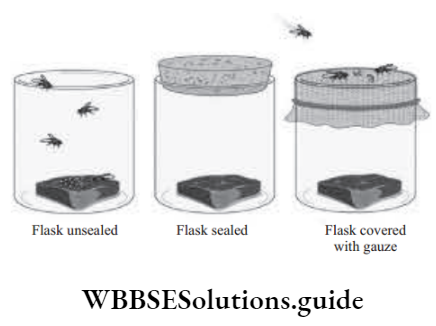
NEET Biology Origin of Life Important Notes
- A series of experiments conducted in the 1860s by the French microbiologist Louis Pasteur (1822–1895) also helped to disprove the idea that life originated by spontaneous generation.
- Pasteur sterilized two containers, both of which contained a broth rich in nutrients. He exposed both containers to the air, but one had a trap in the form of a loop in a connecting tube, which prevented dust and other particles from reaching the broth.
- Bacteria and mold quickly grew in the open container and made its broth cloudy and rank, but the container with the trap remained sterile. Pasteur interpreted this experiment as indicating that microorganisms did not arise spontaneously in the open container but were introduced by dust and other airborne contaminants.
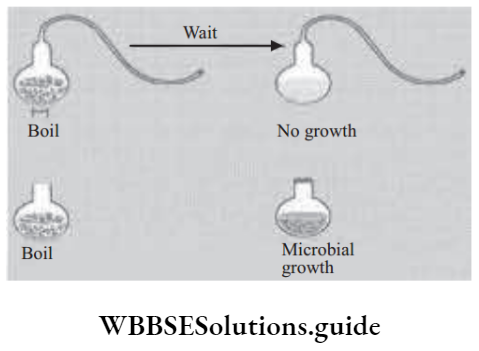
Best Short Notes for Class 9 Biology Origin of Life
Although Redi, Pasteur, and other scientists thoroughly disproved the theory of spontaneous generation as an explanation for the origin of present-day life on whatever scale, they raised a new question.
If organisms can arise only from other organisms, then how did the first organism arise?
Chemosynthetic Theory Of Origin Of Life
- The widely accepted theory is the Chemosynthetic theory of the origin of life proposed by A.I. Oparin. It states that life originated on Earth through a series of combinations of chemical substances in the distant past. All these processes took place in water.
- The earth originated about 5 billion years ago. It was initially made up of hot gases and vapors of various chemicals. Heavy elements such as iron and nickel were found in the center while comparatively lighter ones like those of aluminium and silicon formed the middle layer.
- The lightest elements like hydrogen, oxygen, and carbon were found in the outermost layer. Due to the extremely high temperature, the atoms of these elements could not combine to form molecules.
- As the earth started cooling gradually, the atoms started combining with one another to form molecules, and a solid crust was formed.
Steps Involved in the Origin of Life on Earth:
The early atmosphere contained ammonia (NH3), water vapor (H2O), hydrogen (H2), and methane (CH4). At that time there was no free oxygen.
1. Formation of Inorganic Molecules and Compounds:
- With a considerable decrease in the earth’s temperature over thousands of years, the atoms of different elements came together at random and formed inorganic molecules.
- Since the lighter elements (hydrogen, oxygen, carbon, and nitrogen) were the most abundant in the outermost layer, their atoms reacted with each other to form the first inorganic molecules.
- The earliest molecules formed were those of hydrogen ( H2), nitrogen ( N2), ammonia (NH3), methane (CH4), carbon dioxide (CO2) and water vapor (H2O).
- All the atoms of oxygen combined with those of hydrogen and carbon to form water vapor and carbon dioxide.
- The energy required for the configuration of these molecules came from the ultraviolet rays in the sunlight or electric discharge, heat, or a combination of these.
Origin of Life Class 9 NEET Key Concepts and Summary
2. Formation of Simple Organic Compounds:
- As the earth cooled further, the primitive inorganic molecules interacted and combined with one another to form simple organic compounds.
- Simple sugars, fatty acids, glycerol, amino acids, and nitrogen bases (purines and pyrimidines) were probably the simple organic compounds that resulted from the interactions of the inorganic molecules. Water vapor present in the primitive atmosphere formed clouds, which then resulted in rainfall continuously for several centuries.
- This rainwater filled the hollows and basins of the earth’s crust to form the oceans. Water in these oceans contains ammonia and methane. These compounds reacted among themselves to form primitive organic compounds. Thus, ocean water provided the basis for the formation of organic compounds.
3. Formation of Complex Organic Compounds:
- The smaller and simpler organic compounds that were formed initially on the earth gradually started combining among themselves to form complex organic compounds.
- Simple sugars combine among themselves to form complex polysaccharides such as starch and cellulose.
- Fatty acids and glycerol molecules combine to form lipids.
- Amino acids combine among themselves to form polypeptides and proteins.
- Purines and pyrimidines combined with simple sugars and phosphates to form nucleotides, which in turn combined to form
nucleic acids. - The heat of the sun probably provided the energy required for the formation of complex organic compounds.
- Haldane suggested that due to the accumulation of complex organic molecules, the sea ultimately became a sort of ‘hot, dilute soup’ where, the molecules collided, reacted, and aggregated to form more complex molecules.
4. Formation of Molecular Aggregates:
- It is suggested that the large organic molecules (formed abiotically in the primitive earth) came together spontaneously and due to intermolecular attraction, formed large colloidal aggregates called coacervates.
- An envelope of water molecules formed around each such aggregate due to the hydrophilic nature of some of these compounds.
- A membrane of fatty acids protects and encloses these molecules, increasing the chances of chemical reactions.
- Gradually, breakdown and building up reactions started for which the energy required was provided by the breakdown reactions.
- The coacervates selectively absorbed proteins and other materials from the ocean resulting in their active growth.
- The coacervates not only started growing rapidly but also started multiplying
5. Formation of First Cells (Protobionts):
- The coacervates were in a state of dynamic equilibrium, constantly taking in new materials from the oceans and releasing degraded materials. Thus, they had all the basic properties of life such as metabolism, growth, and reproduction.
- However, they lacked the complexity of molecular organization, catalytic proteins (enzymes), and precise control of nucleic acids. Later, the nucleic acids are said to have taken control of coacervate and the process of replication became precise in the due course of time.
- With the nucleic acids being established as the genetic material, the coacervates got transformed into primitive living systems which have been called protobionts or eobionts.
NEET Biology Class 9 Chapter 7 Detailed Notes with Explanation
6. First life forms:
- The first forms of life developed among the organic molecules, in the oxygen-free atmosphere. They were heterotrophs, requiring ready-made organic compounds as food.
- The early atmosphere of Earth had no free oxygen, the forms until then could at best be only “anaerobic”. Chlorophyll-bearing organisms later released free oxygen which gave greater possibilities for life to evolve.
Chemoheterotrophs : (Greek-Chemo: Chemical, hetero: another, trophy: nourishment):
Chemoheterotrophs are anaerobic prokaryotes like bacteria that depend nutritionally on an external supply of organic compounds. They are dependent on the organic molecules present in the broth for bodybuilding and obtaining energy.
Chemoautotrophs (Greek-Chemo: Chemical, auto: self, trophy: nourishment):
- Chemoautotrophs are organisms that obtain energy through a chemical process, which is by the oxidation of electron-donating molecules from the environment, rather than by photosynthesis.
- Evolutionary scientists believe that chemoautotrophs produced oxygen as a by-product and later evolved into both, aerobic animallike organisms and photosynthetic organisms.
Aerobic Photoautotrophs:
They evolved 3300 to 3500 million years ago. They were like present-day cyanobacteria and could release O2 into the atmosphere because they used water as the reagent. Thus, the whole reducing atmosphere changed to an oxidizing atmosphere.
The appearance of photosynthetic organisms resulted in the release of free molecular oxygen into the atmosphere gradually transforming it into an oxidizing type from the existing reducing type
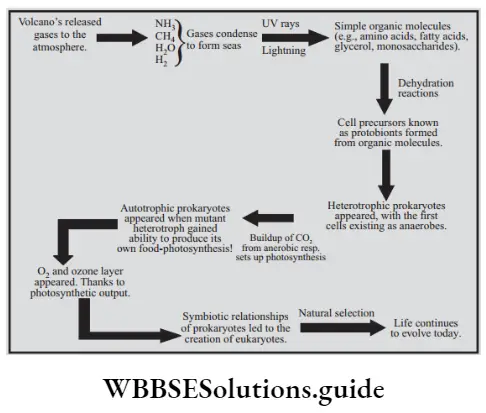
NEET Study Material for Origin of Life Chapter
Evolution
- There is a huge number of living organisms on earth. In addition to this huge diversity of living organisms, the remains of dead organisms are also known. The remains of the organisms that once existed on Earth are known as fossils.
- Now the question arises, how and from where such a great diversity of living organisms came on this earth? The branch of biology that deals with the study of such changes in organisms is known as evolution.
- Evolution is the formation of complex organisms through ‘change’ from simple ancestral types over the course of geological time.
- It is the constant process of evolution (since the origin of life) that has resulted in an enormous variety of plants and animals that have come to exist on this earth at present. All the plants and animals that we see today around us have evolved from some or other ancestors that lived on this earth long, long ago.
- The term organic evolution is used to describe the slow and gradual process by which living organisms have undergone changes from the simplest unicellular forms of life to the most complex multi-cellular forms that can be seen today.
- The characteristics of organisms that had been changing in the past; are changing even today, and will continue to do so in the future as well. This is due to the fact that the environment in which organisms live also changes and organisms need to be adapted to survive in the changed environment.
This process of origin of the various forms(species) found on earth has been a gradual and extremely slow process, requiring hundreds or even thousands of years.
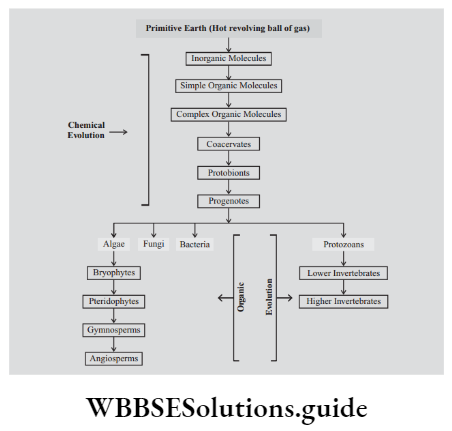
Origin of Life Class 9 NCERT Notes for NEET
Evidence For Evolution
- A number of common features of different kinds of organisms provide evidence in favor of evolution because they are considered to have evolved from common ancestors.
- For example, in a family, a brother and sister are closely related and they have a recent common ancestor i.e., their parents. A brother and his cousin are also related but less than the sister and her brother.
- This is because the brother and his cousin have a common ancestor i.e., their grandparents in the second generation. With subsequent generations, the variations make organisms more different than their ancestors.
Let us discuss some of the important sources that provide evidence for evolution.
1. Homologous organs: Homologous organs are similar in origin (or are embryologically similar) but perform different functions.
- For example, the forelimbs of humans and the wings of birds look different externally but their skeletal structure is similar.
- It means that their origin is similar (as wings in birds are modifications of the forearm) but their functions are different – the wings help in flight whereas the human forearm helps in various activities.
2. Analogous organs: Analogous organs have different origins but perform similar functions.
For example, the wings of a bird and a bat are similar in function but this similarity does not mean that these animals are more closely related. If we carefully look at these structures, then we will find that the wings of a bat are just the folds of skin that are stretched between its fingers whereas the wings of birds are present all along the arm. Therefore, these organs are analogous organs.
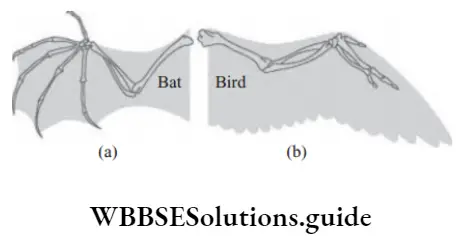
Theories of Origin of Life NEET Notes
3. Fossils: Fossils are the remains of the organisms that once existed on earth. They represent the ancestors of the plants and animals that are alive today. They provide evidence of evolution by revealing the characteristics of past organisms and the changes that have occurred in these organisms to give rise to the present organisms. Thus, fossils discovered provide the ancestral history of an individual.
Let us understand this, with the help of an example.
- Around 100 million years ago, some invertebrates died and were buried in the soil in that area. More sediment accumulated on top of it turning it into sedimentary rock.
- At the same place, millions of years later, some dinosaurs died and their bodies were buried on top of the sedimentary rock. The mud containing dinosaurs also turned into a rock.
- Then, millions of years later, some horse-like creatures died in that area and got fossilized in rocks above the dinosaur fossils. Sometime later, due to soil erosion or floods in that area, the rocks containing horse-like fossils are exposed. If that area is excavated deeper, then the dinosaur and invertebrate fossils can also be found.
- Thus, by digging that area, scientists can easily predict that horse-like animals evolved later than the dinosaurs and the invertebrates. Thus, the above example suggests that the fossils found closer to the surface of the earth are more recent than the fossils present in deeper layers.
